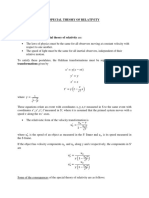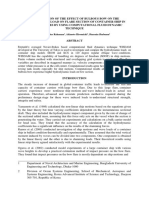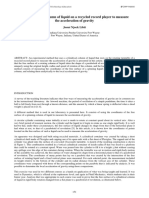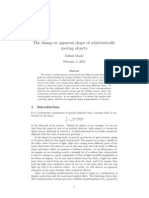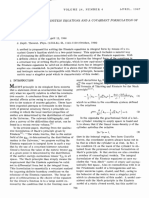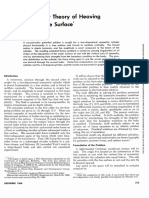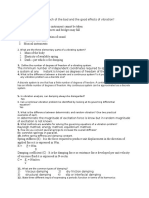The Added Mass Coefficient Computation of Sphere, Ellipsoid and Marine Propellers Using Boundary Element Method
The Added Mass Coefficient Computation of Sphere, Ellipsoid and Marine Propellers Using Boundary Element Method
Uploaded by
santoshCopyright:
Available Formats
The Added Mass Coefficient Computation of Sphere, Ellipsoid and Marine Propellers Using Boundary Element Method
The Added Mass Coefficient Computation of Sphere, Ellipsoid and Marine Propellers Using Boundary Element Method
Uploaded by
santoshOriginal Description:
Original Title
Copyright
Available Formats
Share this document
Did you find this document useful?
Is this content inappropriate?
Copyright:
Available Formats
The Added Mass Coefficient Computation of Sphere, Ellipsoid and Marine Propellers Using Boundary Element Method
The Added Mass Coefficient Computation of Sphere, Ellipsoid and Marine Propellers Using Boundary Element Method
Uploaded by
santoshCopyright:
Available Formats
POLISH MARITIME RESEARCH 1(68) 2011 Vol 18; pp.
17-26
10.2478/v10012-011-0003-1
The Added Mass Coefficient computation
of sphere, ellipsoid and marine propellers
using Boundary Element Method
Hassan Ghassemi, Assoc. Prof.
Amirkabir University of Technology
Ehsan Yari, M. Sc.
Malekashtar University of Technology
ABSTRACT
Added mass is an important and effective dynamic coefficient in accelerating, non uniform motion as a result
of fluid accelerating around a body. It plays an important role, especially in vessel roll motion, control
parameters as well as in analyzing the local and global vibration of a vessel and its parts like propellers
and rudders. In this article, calculating the Added Mass Coefficient has been examined for a sphere,
ellipsoid, marine propeller and hydrofoil; using numerical Boundary Element Method. Since an Ellipsoid
and a sphere have simple geometric shapes and the Analytical values of their added mass coefficients
are available, so that the results of added mass matrix are obtained and evaluated, using the boundary
element method. Then the added mass matrix is computed in a given geometrical and flow specifications
for a specific propeller and its results are studied versus experimental results, which it’s current numerical
data In comparison with other numerical methods has a good conformity with experimental results. The
most important advantage of the method in determining the added mass matrix coefficients for the surface
and underwater vessels and the marine propellers is extracting all the added mass coefficients with very
good Accuracy, while in other numerical methods it is impossible to extract all the coefficients with the
Desired Accuracy.
Key words: Added mass coefficient; Boundary element method; Marine propeller; Ellipsoid
INTRODUCTION THE ADDED MASS COEFFICIENT
RELATIONS
In fluid mechanics, added mass or virtual mass, is the added
inertia to the system, owing to that the Increase or decrease in The hydrodynamic forces and moments are determined by
the body acceleration should cause the Fluid to move around the fluid inertia and viscous properties according to the motion of
body in such a way that the object can move through it, because a body in real incompressible fluid. Definitely, the other forces
the body and the fluid cannot simultaneously occupy this and moments can be calculated by obtaining one of the inertia
physical space. For simplicity this can be modeled in such a way or viscous terms. Since the fluid can be assumed as an ideal
that the Volume of fluid moves along the object, While in fact one (Inviscid). Therefore the inertia forces and moments can
all parts of the fluid move with varying degrees. Added mass be calculated with this estimate. The forces and moments of
coefficient matrix usually is expressed as a dimensionless value inertia can be introduced as the body added mass terms, using
which is equal to added mass coefficient divided by the Mass of this method.
displaced fluid. For example the body density can be considered Assume that the body with surface S is moving in an infinite
in the body volume. In general, the added mass coefficient is homogeneous ideal Fluid. Consider two systems of coordinates:
a second order tensor that depends on the fluid acceleration the stationary one (We denote it by XYZ) and the coordinate
vector in order to obtain force vector on the body. system moving together with the body (We denote it by Oxyz).
The added mass was considered as the first time in 1776 by The vortex-free condition implies the existence of a potential
Dubua who did laboratory studies on spherical pendulum in φ(X, Y, Z, t), assuming that the moment of these two systems
low swings. [2] Precise mathematical equations for the added of coordinate are specified. So the components of the fluid
mass of sphere, was obtained by Green (1833) and Stokes velocity are defined as follows:
(1843) respectively. Stokes, also studied on the sphere motions
in a finite volume of fluid. Later, following the efforts of many
(1)
researchers, the concept of added mass was generalized for
moving a desired object in different flow regimes. [3]
POLISH MARITIME RESEARCH, No 1/2011 17
Using the continuity and incompressibility of fluid and due In the above equation fi, i = 1, 2, 3 are the flow potentials
to the vortex-free condition as mentioned above the Laplace corresponding to the body moving along the axes x, y, z at unit
equation is implied as follows: linear velocities, respectively. On the other hand φi, i = 4, 5, 6
are potentials, corresponding to rotation of the body around the
(2) same axes at unit angular velocities respectively. It is seen that
the body motion in an ideal infinite fluid causes to solve six
The boundary conditions for Eq. (2) look as follows: problems. The first problem can be formulated as follows: the
solution of the Laplace equation Δφ1 = 0 will be found, using
1. The watertight condition, valid on the surface S:
the following boundary conditions:
(3)
(10)
Where ( ) is a projection of fluid velocity on the
(external) direction n, which is normal to surface S; un is the (11)
velocity projection of a point of the body, normal to surface n.
2. Stationary condition at infinity:
The function is given on the surface S and The last
(4) (sixth) problem, taking (8) into account. To solve the problem,
considering the Laplace equation Δφ6 = 0 using the following
boundary conditions: which is given at the
Where r2 = X2 + Y2 + Z2 (r is the distance from the origin to
surface S, so:
a fluid point). The function φ vanishes at infinity as 1/r2, whereas
its first-order coordinate derivatives vanish as 1/r3 [4, 5]
From the formulation of the problem (1-4) it is seen that
the function φ depends on time t via the boundary condition
It can be seen that the function φi, i = 1, 2,... 6 does not
of right-hand side equation (3), so the boundary condition is
depend on u0 and ω0. These functions are determined only by
investigated specifically. The origin O is chosen to coincide
the shape of the surface S of the body and Choice of coordinate
with an arbitrary point of the body
system Oxyz attached to the body.
The velocity of the point O is Denoted by (components
u0x, u0y, u0z are projections of the vector u0 on coordinate axes
attached to the body).
KINETIC ENERGY OF THE FLUID
The angular velocity of the body with respect to the point O
In order to to obtain fluid kinetic energy, considering the
is also donated by (components of in the same coordinate
surface S and the sphere Σ of radius a including the body with
system are denoted by ωx, ωy, ωz). Thus, the velocity of an
surrounding Fluid, the following integral is defined.
arbitrary point of the body, including any point of its surface
S, is determined by the following equation:
(5)
(12)
Where is the vector, determining the position of the point.
The components of Eq. (5) look as follows:
(6)
Where ρ, is the fluid Density
Using Green’s transformation for two functions (φ1, φ2):
On the surface S we have:
(7)
Writing: α ≡ cos(n, x); β ≡ cos(n, y); γ ≡ cos(n, z) and (13)
substituting (6) into (7), the following form of the boundary
condition is obtained (3):
And considering φ1 = φ2 = φ, Δφ = 0 and putting words in
(8) the above equation the following expression is gotten:
(14)
In the formula (8) the variables α, β, γ, yγ – zβ, zα – xγ,
The Second term in the right hand side of Eq. (14) tends
xβ – yα are determined only based on the shape of the body
to zero as α → ∞ according to the asymptotic behavior of φ
surface. The body motion and the dynamics of the flow
and its first derivatives while r → ∞. Therefore, the following
are determined by the functions u0x, u0y, u0z, ωx, ωy, ωz. The
formula is obtained for the total kinetic energy of the fluid
potential φ is represented as follows, due to the Linearity of
around the surface S:
the problem.
(9) (15)
18 POLISH MARITIME RESEARCH, No 1/2011
Substituting the expression (9) in to (15) and writing:
The expression (16) is finally obtained:
(16)
Where λik is:
(17) Fig. 1. Application of Green theory for hydrofoils
λik is called the added mass of the body. With these assumptions, the flow field around the body can
According to Eq. (17) it is found that the added mass, do be identified using Perturbation Velocity potential φ, which
not depend on the body velocity and Kinematics of the motion satisfies the Laplace equation:
but is only a function of the body surface geometry. ∇2φ = 0 (21)
Applying Green’s formula to functions φi and φk in the
volume V between the surfaces Σ and S then: To solving the problem, the boundary conditions are
considered as follows:
(18) Kinematic Boundary Condition
Based on the Kinematic boundary condition, the Flow
velocity normal to the body surface must be zero.
Since Δφi = Δφk = 0, so that the left-hand side of the equation
equals zero, and the first term of the right-hand side of the (22)
equation tends to zero at α → ∞. Therefore, the condition for
the infinite fluid surrounding the body is as follows: Where , is the unit vector normal to outside of the boundary
[8] and is changed as follows, considering the unit potential
(19) Kinematic of Boundary Condition:
Since λik = λki. Therefore, only 21 values out of 36 λik (i, k =
= 1, 2… 6) are independent. (23)
This part, in fact proved that the added mass matrix is
symmetric.
To obtain the added mass coefficient matrix using force Where, r is a vertical distance from a fixed origin point
view, ultimately the same formula is achieved. [6] [12].
CALCULATING THE ADDED MASS Kinematic And Dynamic Conditions In Wake
COEFFICIENT USING THE BOUNDARY
ELEMENT METHOD Based on this condition, there is no velocity jump of flow
on the wake vortex, however there is velocity jump of potential
Boundary element method is based on the Green’s theory. on the surface which is equal to circulation Г around the fin.
Based on the theory solving the fluid flow around the body can The mathematical relations of flow velocity and potential are
be transferred from the volume solving domain around the body expressed as follows:
to the body boundary that is performed on the produced surface
elements in three-dimensional modes. The boundary element
method is used to obtain all six unit potentials corresponding to (24)
the six free degrees. The added mass tensor can be computed,
obtaining the unit potential. The forces and momentum also
can be achieved, having the added mass. [7] Where B and F showing back and face sides of the propeller
[8].
(20)
KUTTA CONDITION IN THE TRAILING
EDGE
THE BOUNDARY ELEMENT METHOD
TO COMPUTE THE ADDED MASS Hess and Smith have shown that the flow passing along
COEFFICIENT a thin and non lifting body can be described by the distribution
singularities of source. But to describe the flow passing along
Consider the Closed area Ω, the boundary S and unit vector lifting bodies, modeled by the circulation distribution on the
normal to S (Fig. 1). The boundary S is composed of the surface, a boundary condition for the Trailing Edge of the body
body wetted surface SB, the wake surface SW and the external must be satisfied, expressing that the velocity at the trailing
control surface S∞ including surface area SB, SW. edge should be limited and unique. [9, 10]
The Ω encountered the Uniform inflow velocity ,
assuming the flow is Incompressible, Inviscid and Irrotational |∇φ|TE < 0 (25)
in the domain Ω, in the upstream flow.
POLISH MARITIME RESEARCH, No 1/2011 19
Surface At Infinity Although the Kutta condition is considered to analyze
the propeller and the hydrofoil, the obtaining results have no
At the boundary surface at infinity S∞, the perturbation significant difference with the ones which are obtained without
velocity due to the body surface must tend to zero. considering the Kutta condition. So, regarding this issue it can
be expressed that only the D and S out of the D, S and W are
∇φ → 0 as S∞ → 0 (26) important for calculating the added mass matrix.
Using Green’s theory, general answers of the Laplace
equation for each point P can be expressed as the following
integral equation: (31)
(27)
Which in Reference 12, the integrals are expressed as
follows that in fact are the same general term in Eq (27) and with
extracting the D and S, the formulas in Eq (31) is obtained.
In the above equation ∂φ/∂n is determined, using the
boundary condition of Eq (23). 1/R(p, q), is the distance
between p and q, so that the only remaining unknown for
solving Eq (27) is φ. [8]
(32)
EQUATIONS DISCRETIZATION
In order to solve Eq (27), the equation form must be discrete
and the body boundary surface shall be made of tetragonal
elements. The Flowchart Of The Added Mass Matrix Extraction
Fractional equations lead to linear algebraic equation system Using The Boundary Element Method
for φ and i as follows:
(28)
Where Dij, Sij, and Wijl are Dipole coefficients and source
for j element that acts on the arithmetic point i. The coefficients
are defined as follows:
(29)
To obtain these coefficients the numerical solution of the
integrals is used. Calculating these coefficients, the following
matrix equation is formed
Solving the equations using the Gauss - Sydl method is done
as a repetitive solving, so that φj are obtained. [11]
[D][φ] = [S] + [W][Δφ] (30)
Where:
[D] = dipole Potential effects of induction coefficient matrix
[S] = source Potential effects of induction coefficient matrix
[W] = dipole Potential effects of induction coefficient matrix
For lifting and non-lifting bodies, the above computational
method can be used, but the difference is in the use of Kutta
boundary condition which there is no need to consider it in
non-lifting bodies, so that the results are obtained directly
regarding the kinematic boundary condition.
20 POLISH MARITIME RESEARCH, No 1/2011
If the above integrals are formulated based on matrix analytical relations in the mass matrix of sphere, only a11, a22 and
equations, the following relation is obtained: a33 have values and the others are zero. The three coefficients
are equal with each other and should be equal to half of the
[AiK][φK] = [Bi] (33)
sphere mass. In order to evaluate the Mesh independency, the
So that i = K and AiK = 2π. added mass matrix were investigated for three cases of surface
The added mass matrix values with solving matrix equations element (2400, 3360 and 4800 elements), using the boundary
for all six potential unit functions can be defined as follows: element numerical code and the obtained results and errors
were checked.
(34) The obtained values for the added mass of the sphere using
numerical analysis of the boundary element are as follows:
If the above equation is written in the matrix form, which
is the general form of added mass matrix. [12]:
For a sphere with radius of 0.25 m, the analytical values of
a11, a22, a33 are equal to 0.0327245
As it was mentioned, only a11, a22, a33 have non-zero
RESULTS value, which is equal to half of the sphere mass and the
Computing The Added Mass Coefficient other elements of the added mass matrix are zero. So it can
Of Sphere be seen that the obtained values of the numerical boundary
element method have a high conformity with the analytical
The added mass coefficient for a sphere of radius 0.25 m data and the error rate, according to the table (3) is the 10E-2
has been investigated in this part. However, according to the order. [6]
Tab. 1. Geometric and flow data to calculate the added mass coefficient of sphere
Tab. 2. Showing the produced geometry with surface elements to check the mesh independency condition
Tab. 3. The compared Results of the added mass numerical and analytical data of the sphere and the Error percentage Due to the elements numbers
% Error
Number of Numerical result for Analytical Difference between
Element a11 (code result) value of a11 Numerical and Analytical result
2400 0.032814 0.032725 8.95E-05 0.272749
3360 0.032771 0.032725 4.65E-05 0.141894
4800 0.032752 0.032725 2.75E-05 0.083964
POLISH MARITIME RESEARCH, No 1/2011 21
Tab. 4. Geometric and flow data of computing the added mass coefficient ellipsoid
Computing The Added Mass Of Ellipsoid Considering that the numerical analysis results of the added
mass were dimensional and the results in the references were
Continue the contex, the coefficient of added mass for an dimensionless, then to validate the results, the data obtained
ellipsoid has been investigated. from the numerical analysis were transformed to dimensionless
Since the added mass coefficients of ellipsoid as well as one and compared with the available data in those references.
the sphere are available in references, so that to validate the To make the added mass matrix of ellipsoid dimensionless a11,
computing results of the boundary element code, this analysis a22 and a33 shall be divided on (4π/3)ab2 and also a44, a55 and a66
is given. The numerical analysis with the mesh independency must be divided on (4π/15)ab2 (a2 + b2).
condition was investigated and the results of the surface element Due to the symmetry of the ellipsoid, then a22 = a33, a55 = a66
with the number of 4600 had very little error in comparison and a44 = 0.
with the existing data. According to data obtained from the Diagram and making
The added mass matrix obtained by numerical analysis for them dimensional, then:
an ellipsoid with the above specification is as follows:
It is found from comparing the boundary element numerical
analysis results with the data available in references for added
mass coefficients of ellipsoid that there is a good conformity
between the numerical data and the ones in the references
[6, 12].
Tab. 5. The added mass coefficient Diagram of an ellipsoid [6]
22 POLISH MARITIME RESEARCH, No 1/2011
Tab. 6. the compared Results of the added mass numerical and analytical data of the ellipsoid and the Error percentage Due to the elements numbers
% Error
Matrix Numerical result Analytical Difference between
array (code result) result Numerical and Analytical result
A11 0.009025 0.00902094 4.06E-06 0.044986
A22 0.143401 0.14306174 0.000339 0.236581
A55 0.030467 0.03120399 -0.00074 -2.41898
Computing The Added Mass Matrix For A Sample Propeller
According to the data and results obtained for the added mass matrix of the sphere and ellipsoid it can be found that there
is a very good accuracy between the data obtained from the analytical and the numerical solution, suggestive of the validity of
the boundary element method code in calculating the added mass matrix.The following text is about computing the added mass
matrix for a sample propeller which its experimental and geometrical data is on hand and the results have been validated with
the experimental data.The added mass matrix, considering what was mentioned in the text do not depends on the body velocity
and is only a function of the body geometry.
First of all, the existing Geometric data of the propeller was considered based on the standards and the propeller geometry
modeled with a very high accuracy. Then the propeller surface and the hub were analyzed according to the flow conditions. The
propeller analysis was performed in several different modes of surface element numbers so that the most appropriate numbers
of the elements is achieved in a way that the obtained answers do not depend on the element numbers [14].
Tab. 7. Geometric and flow data related to the propeller and the produced geometry for boundary element numerical analysis [13]
Dimensional Added Mass Matrix Obtained For The Propeller
2.176192 -0.240440 -0.686280 -0.670630 0.015638 -0.196440
-0.240440 0.042111 0.080637 0.006256 0.000156 0.018995
-0.686280 0.080637 0.251128 0.019366 -0.005240 0.059255
Added Mass Matrix =
-0.058640 0.006256 0.019366 0.001617 -0.000450 0.005282
0.015638 0.000156 -0.005240 -0.000450 0.000505 -0.001630
-0.196440 0.018995 0.059255 0.005282 -0.001630 0.018315
POLISH MARITIME RESEARCH, No 1/2011 23
Tab. 8. Compared results of the added mass numerical and analytical data of the propeller and the Error percentage Due to the element numbers
Numerical result Diffrence between % Error
Number of Exprimental
Matrix Array A13 Numerical and Exprimental
Element Result
(Addedprop code) result
1800 0.6242060 0.6860000 -0.0617940 -9.0078717
2520 0.6382161 0.6860000 -0.0477839 -6.9655831
3240 0.6451033 0.6860000 -0.0408967 -5.9616181
3960 0.6510313 0.6860000 -0.0349687 -5.0974781
4320 0.6631462 0.6860000 -0.0228538 -3.3314577
5040 0.6691640 0.6860000 -0.0168360 -2.4542274
5760 0.6706359 0.6860000 -0.0153641 -2.2396647
Investigating The Mesh Independency
To investigate that the obtained data for the propeller is independent of the produced surface elements of the propeller and the
hub surface, the added mass matrix was obtained in seven different numbers of surface elements and the results were checked,
as it is identified from the diagram (figure 2) the results do not have any significant change after 3960 elements.
Fig. 2. Changes in the mass added coefficient based on the element numbers at the propeller surface
Comparing The Added Mass Matrix Of The Propeller With The Obtained Data From Other
Numerical And Experimental Methods
Tab. 9. Comparing the data, obtained from the numerical solution, experimental and formulated data
Added Mass Diff
Estimation Method
(kg) [%]
Experiment 0.6860000 0.0
AddedProp (Present method) 0.6706359 -2.24%
Prodas 0.6690000 -2.5%
Schwanecke 0.8240000 +20.1%
Shuster 0.9660000 +40.8%
24 POLISH MARITIME RESEARCH, No 1/2011
Computing The Added Mass Matrix Of The Hydrofoil (NACA0012 Section)
Tab. 10. Geometrical data and the element numbers of calculating the added mass coefficient of hydrofoil
Gradual Increase In The Span Length To Validate The Results
To calculate the added mass matrix of the hydrofoil with NACA0012 section, first of all the mesh independency was
investigated in which the obtained data from 2632 elements had very good accuracy, then to validate the obtained data, the span
length was increased gradually from 0.2 to 1 and thus the added mass matrix was computed. Afterward the added mass matrix
element changes were plotted based on the span length increase. All of the coefficients are increased with linear and non-linear
curves of the 2 and 3 order, which is completely ascending. In fact, by increasing the Span length, all coefficients were reasonably
increased as expected. Of course, investigating each of the diagrams whether they should be linear or nonlinear, of the 2 orders
or 3 orders are denied due to that they are Proportional to Dynamic and Simulation topics.
Fig. 3. The added mass coefficient changes of hydrofoil based on the gradually increase along the Span length
The Added Mass Matrix Of Hydrofoil
The added mass matrix of hydrofoil with NACA0012 section for the Span length of 1 m and Chord length of 9/0 m is as
follows:
159.3152 31.63824 0 -13.5806 89.37951 58.75352
31.63824 122.4136 0 -63.4481 11.35911 44.82613
Added Mass Matrix = 0 0 0 0 0 0
-13.5806 -63.4481 0 40.92427 -7.51047 -23.5442
89.37951 11.35911 0 -7.51047 56.3155 21.46682
58.75352 44.82613 0 -23.5442 21.46682 22.75078
POLISH MARITIME RESEARCH, No 1/2011 25
CONCLUSION 2. Birkhoff, G.: Hydrodynamics. Princeton Univ. Press, Princeton,
1960
• The added mass coefficient is one of the most important 3. Lamb, G.: Hydrodynamics. Cambridge University Press, Cambridge,
1932
dynamic coefficients in solving dynamic equations and
4. Kochin, N.E., Kibel, I.A., Rose, N.V.: Theoretical Hydromechanics,
simulating the vessels. Calculating the Add mass coefficient Parts I and II. State Publisher of Physical and Mathematical
especially the bodies whose shapes are not simple is Literature, Moscow, in Russian, 1963
difficult. Added mass coefficient is extractable using 5. Taylor, J.L.: Some hydrodynamical inertia coefficients. Phil. Mag.
empirical formulas, the simple analytical relations and Ser. 7 9(55), 161-183, 1930
numerical methods such as Strip theory and lab tests. 6. Alexandr I. Korotkin: Added mass of ship structure. Fluid mechanics
• But each of these methods can be used in a limited range. and its applications, Volume 88, 2009
For example, the analysis relations can be used only for 7. John T. Katsikadelis: Boundary Elements, Theory and Applications,
simple geometries and lab tests to extract the added mass Elsevier Science Ltd, 2002
are costly and obtaining all matrix coefficients is very 8. Kinnas S.A. and Hsin C.Y.: Boundary Element Method for the
Analysis of the Unsteady Flow around Extreme Propeller Geometry.
difficult. Moreover, the numerical methods cannot model
IAA, Journal, 30 (3), 1992
the full three-dimensional body and have a lot of errors 9. Hess J.T, Smith A.M.: Lecture 3 AA200b January 13-18, 2005
that ultimately causing a large deviation in calculating 10.Hess J.T, Smith A.M.: Calculation of nonlifting potential flow about
the coefficients. Meanwhile since the boundary element arbitrary three-dimensional bodies. Journal of Ship Research, 8(2),
method solves the problem on surface boundary elements 1964
of the body, it needs less elements and time to solve and 11. Morino L. and Kuo C.C.: Subsonic Potential Aerodynamics for
can obtain the added mass coefficients owing to modeling Complex Configuration: A general Theory. AIAA Journal, 12 (2),
the full three-dimensional body and also extracting the 191-197, 1974
potential values with high accuracy. 12.Olivier Saout.: Computation of Hydrodynamic Coefficients and
• As mentioned in the article to investigate the mesh Determination of Dynamic Stability Characteristics of an Underwater
Vehicle Including Free Surface Effects. Ms Thesis,Florida Atlantic
independency, the added mass matrix of an ellipsoid and
University, May 2003
a sphere of specific geometry were extracted, using the 13.Young-Joong Kim, Hyun Yup Lee and Chang-Sup Lee: The Added
boundary element method and the results were validated Mass and Damping for the Axial Rigid Body Motion of a Marine
with the analytical data. Propeller Rotating in a Uniform Flow. Journal of the Society
• Afterward the added mass matrix for a certain propeller was of Naval Architects of Korea, Vol. 45, No. 3, pp. 309-314, June
computed which its results had a very good conformity with 2008
the experimental ones. However due to lack of access to 14.Donald M. MacPherson and Vincent R. Puleo and Matthew B.
distribution Cord of the propeller, the standard distribution Packard, Estimation of Entrained Water Added Mass Properties for
of Series B for a propeller with specific section (NACAa66) Vibration Analysis, SNAME New England Section, June 2007.
was used, considering that the volume of the produced
propeller geometry was checked with the volume of the
examined propeller in a way that the geometry would have CONTACT WITH THE AUTHORS
a high conformity with the existing data so that if the exact Hassan Ghassemi, Assoc. Prof.
geometry is on hand, the error rate with be lower than 10E-2 Faculty of Marine Technology
order. Amirkabir University of Technology
• To put it in a nut shell, extracting a complete and dimensional Hafez Ave.,
add mass matrix with any desired geometry and the accuracy Tehran, IRAN
of obtained data is the difference between this method and e-mail: gasemi@cic.aut.ac.ir
boundary element code with other numerical methods.
Ehsan Yari, M. Sc.
BIBLIOGRAPHY Faculty of Marine Engineering,
Malekashtar University of Technology,
1. Newman, John Nicholas: Marine hydrodynamics. Cambridge,
Massachusetts, MIT Press. ISBN: 0-262-14026-8 §4.13, p. 139, Shahinshar,
1977 Isfahan, IRAN
26 POLISH MARITIME RESEARCH, No 1/2011
You might also like
- 300 Solved ProblemsDocument503 pages300 Solved ProblemsVenketaramani Tiruchirapalli95% (38)
- Manual Servicio SullairDocument94 pagesManual Servicio SullairLytmerAcuñaNo ratings yet
- The Theory of Relativity: And Other EssaysFrom EverandThe Theory of Relativity: And Other EssaysRating: 4.5 out of 5 stars4.5/5 (11)
- Internal and External Spline Teeth - Gears - Internal and External Spline Teeth, SplineDocument14 pagesInternal and External Spline Teeth - Gears - Internal and External Spline Teeth, Splineagusw100% (1)
- Physical Approach To Cosmological Homogeneity: G Pup oDocument4 pagesPhysical Approach To Cosmological Homogeneity: G Pup oKaustubhNo ratings yet
- Viscous Flow Around Spherical Particles in Different ArrangementsDocument11 pagesViscous Flow Around Spherical Particles in Different ArrangementsLuis RiosNo ratings yet
- Worksheet PHYS1004 STR Unit1Document8 pagesWorksheet PHYS1004 STR Unit1Anurag RanaNo ratings yet
- The Motion o F Ellipsoidal Particles Immersed A Viscous FluidDocument19 pagesThe Motion o F Ellipsoidal Particles Immersed A Viscous FluidHua Hidari YangNo ratings yet
- Ships DynamicDocument18 pagesShips Dynamicanilsingh1983100% (1)
- Foucult PendulumDocument7 pagesFoucult PendulumkanchankonwarNo ratings yet
- Eotvos EffectDocument5 pagesEotvos Effectjoff_grNo ratings yet
- Fluid Mechanics (MR 231) Lecture Notes (8) Fluid Kinematics: X X V VDocument6 pagesFluid Mechanics (MR 231) Lecture Notes (8) Fluid Kinematics: X X V VAhmedTahaNo ratings yet
- EuleDocument9 pagesEuleAnand Utsav KapoorNo ratings yet
- Measuring The Inclination and Mass-To-Light Ratio of Axisymmetric Galaxies Via Anisotropic Jeans Models of Stellar KinematicsDocument16 pagesMeasuring The Inclination and Mass-To-Light Ratio of Axisymmetric Galaxies Via Anisotropic Jeans Models of Stellar KinematicsMajo BuroNo ratings yet
- Jeffery - 1922 - The Motion of Ellipsoidal Particles Immersed in A Viscous FluidDocument20 pagesJeffery - 1922 - The Motion of Ellipsoidal Particles Immersed in A Viscous Fluidzihou.liuNo ratings yet
- Investigation of The Effect of Bulbous Bow - Paper For NOAMI - 15.01.2014Document16 pagesInvestigation of The Effect of Bulbous Bow - Paper For NOAMI - 15.01.2014mtarequeali5836No ratings yet
- Foucault PendulumDocument19 pagesFoucault PendulumBrijesh ThakkarNo ratings yet
- Pendulum PDFDocument3 pagesPendulum PDFss_nainamohammedNo ratings yet
- Mic 2007 1 3Document12 pagesMic 2007 1 3Sachin ShendeNo ratings yet
- Motion of A Rigid Body in Body-Fixed Coordinate System - An Example For Autoparrallel Trajectories in Spaces With TorsionDocument13 pagesMotion of A Rigid Body in Body-Fixed Coordinate System - An Example For Autoparrallel Trajectories in Spaces With TorsionAscanio BarbosaNo ratings yet
- Numerical Wave Tanks Based On Finite Element and BoundaryDocument22 pagesNumerical Wave Tanks Based On Finite Element and BoundarygreynoiseNo ratings yet
- Nonlinear Time-Domain Strip Theory Formulation For Low-Speed Maneuvering and Station-KeepingDocument22 pagesNonlinear Time-Domain Strip Theory Formulation For Low-Speed Maneuvering and Station-KeepingHussien El-masryNo ratings yet
- HydrodynamicsDocument9 pagesHydrodynamicsOur SalahEddineNo ratings yet
- ElastostaticDocument39 pagesElastostaticibrodel22No ratings yet
- FossenDocument21 pagesFossenEgwuatu UchennaNo ratings yet
- Experimental Aspects of The Gyroscope's MovementDocument7 pagesExperimental Aspects of The Gyroscope's MovementCassie MinorNo ratings yet
- Big-Bounce CosmologyDocument35 pagesBig-Bounce CosmologySac EndlichNo ratings yet
- Dynamics-Assigment 2Document16 pagesDynamics-Assigment 2imran5705074No ratings yet
- Geofisical Fluid Dinam 1d1Document5 pagesGeofisical Fluid Dinam 1d1koalagrisNo ratings yet
- Oase ProjectDocument13 pagesOase ProjectAisien ZionNo ratings yet
- 1973-62 Simplified Theory of Rolling ContactDocument6 pages1973-62 Simplified Theory of Rolling ContactStefan TudoracheNo ratings yet
- Surfaces With Common Geodesic in Minkowski 3-Space: Emin Kasap, F. Talay AkyildizDocument11 pagesSurfaces With Common Geodesic in Minkowski 3-Space: Emin Kasap, F. Talay AkyildizIstván EstélyiNo ratings yet
- LQGDocument64 pagesLQGstephenNo ratings yet
- Using A Rotating Column of Liquid On A Recycled Record Player To Measure The Acceleration of GravityDocument6 pagesUsing A Rotating Column of Liquid On A Recycled Record Player To Measure The Acceleration of GravitykostanNo ratings yet
- Chapter-1: 1.1 Motivation of The ThesisDocument25 pagesChapter-1: 1.1 Motivation of The ThesisAnjali PriyaNo ratings yet
- A Closed Form Solution of The Two Body Problem in Non-Inertial Reference FramesDocument20 pagesA Closed Form Solution of The Two Body Problem in Non-Inertial Reference Framesshakir hussainNo ratings yet
- Chapter2 - Strip TheoryDocument44 pagesChapter2 - Strip Theoryyehia NasserNo ratings yet
- Shape of Relativistically Moving ObjectsDocument9 pagesShape of Relativistically Moving ObjectsDalimil MazáčNo ratings yet
- Ragazzo-Ruiz2017 Article ViscoelasticTidesModelsForUseIDocument41 pagesRagazzo-Ruiz2017 Article ViscoelasticTidesModelsForUseIVishnu ViswanathanNo ratings yet
- STiCM Assignment 1Document2 pagesSTiCM Assignment 1Sahil ChadhaNo ratings yet
- Articulo4 2005Document13 pagesArticulo4 2005Klaus-BärbelvonMolchhagenNo ratings yet
- Chapter 7. Covariant Formulation of Electrodynamics: NotesDocument24 pagesChapter 7. Covariant Formulation of Electrodynamics: NotesAnimesh GargNo ratings yet
- H.K. Moffatt, Y. Shimomura and M. Branicki - Dynamics of An Axisymmetric Body Spinning On A Horizontal Surface. I. Stability and The Gyroscopic ApproximationDocument30 pagesH.K. Moffatt, Y. Shimomura and M. Branicki - Dynamics of An Axisymmetric Body Spinning On A Horizontal Surface. I. Stability and The Gyroscopic ApproximationVortices3443No ratings yet
- Continuity Equation - Differential Form: DerivationDocument15 pagesContinuity Equation - Differential Form: Derivationprasanth_karthiNo ratings yet
- Aerodynamics AME 208: Chapter 2: Fundamentals of FluidDocument44 pagesAerodynamics AME 208: Chapter 2: Fundamentals of FluidAngeline ChasakaraNo ratings yet
- ME 219: Fluid MechanicsDocument10 pagesME 219: Fluid Mechanicsharshitsingariya1181No ratings yet
- Numerical - Simulation - of - The - Effect - of - Wind - On THE MISSILE MOTIONDocument10 pagesNumerical - Simulation - of - The - Effect - of - Wind - On THE MISSILE MOTIONscorpion_l_81No ratings yet
- TUSHAR - KANTI - SAHAMechanics-22020-03-28Mechanics-T.K. SAHA-Notes 2Document7 pagesTUSHAR - KANTI - SAHAMechanics-22020-03-28Mechanics-T.K. SAHA-Notes 2Kofi EduseiNo ratings yet
- Lorentz Transformations: A Group Theory Approach: Neil & Pillon Erik October 21, 2017Document3 pagesLorentz Transformations: A Group Theory Approach: Neil & Pillon Erik October 21, 2017abbeyNo ratings yet
- FM - HT - Unit 1Document100 pagesFM - HT - Unit 1Monica ChandniNo ratings yet
- Al'tshuler-Integral Form of The Einstein Equations and A Covariant Formulation of Mach's PrincipleDocument6 pagesAl'tshuler-Integral Form of The Einstein Equations and A Covariant Formulation of Mach's PrincipleH LNo ratings yet
- RelangmomDocument19 pagesRelangmomLeomar Acosta BallesterosNo ratings yet
- Natural Modes of The Two-Fluid Model of Two-PhaseDocument17 pagesNatural Modes of The Two-Fluid Model of Two-PhasecleuberNo ratings yet
- Turbulent Flow Notes AECDocument33 pagesTurbulent Flow Notes AECKaushik BarmanNo ratings yet
- Graziani-Bassanini Unsteady Viscous Flows About Bodies Vorticity Release and Forces 2002Document22 pagesGraziani-Bassanini Unsteady Viscous Flows About Bodies Vorticity Release and Forces 2002Hariharan RamanathanNo ratings yet
- Stokes' and Newton's Viscous DragDocument7 pagesStokes' and Newton's Viscous DragL V SatyavathiNo ratings yet
- 2020 Navarro Martinez-Belda ComputMathMethods AcceptedDocument15 pages2020 Navarro Martinez-Belda ComputMathMethods AcceptedZahra BoureghdaNo ratings yet
- Generalization of The Gibbs-Thomson EquationDocument16 pagesGeneralization of The Gibbs-Thomson EquationDaniela Silva MolinaNo ratings yet
- The Second-Order Theory of Heaving Cylinders in A Free SurfaceDocument15 pagesThe Second-Order Theory of Heaving Cylinders in A Free SurfacevictorNo ratings yet
- The Differential Equations of FlowDocument12 pagesThe Differential Equations of Flowsundari_muraliNo ratings yet
- BAB 6 GelombangDocument25 pagesBAB 6 GelombangAndrean RevaldoNo ratings yet
- Full Free Motion of Celestial Bodies Around a Central Mass - Why Do They Mostly Orbit in the Equatorial Plane?From EverandFull Free Motion of Celestial Bodies Around a Central Mass - Why Do They Mostly Orbit in the Equatorial Plane?No ratings yet
- Scaffold Inspection ChecklistDocument3 pagesScaffold Inspection Checklistengrabbas75No ratings yet
- P220 PDFDocument4 pagesP220 PDFGustavo Brea MalavéNo ratings yet
- Preeti (CV)Document4 pagesPreeti (CV)Preeti SahakateNo ratings yet
- Unit 2Document7 pagesUnit 2VINEET VYASNo ratings yet
- 2023-01-18 InspectionDocument5 pages2023-01-18 InspectionRega PrimastaNo ratings yet
- Wessington Cryogenics Company Profile and ProductsDocument92 pagesWessington Cryogenics Company Profile and ProductsAdmin OceanergyNo ratings yet
- The Impact Resistance of Composite Materials PDFDocument16 pagesThe Impact Resistance of Composite Materials PDFSergio A. Ardila ParraNo ratings yet
- Chapter 12Document33 pagesChapter 12Norman ChenNo ratings yet
- The Benson Boiler Turns 75Document4 pagesThe Benson Boiler Turns 75Rio HuangNo ratings yet
- CHE 503 Power Consumption in AgitatorDocument16 pagesCHE 503 Power Consumption in AgitatorNurtasha AtikahNo ratings yet
- Moody SiDocument1 pageMoody SiLuz NuñezNo ratings yet
- 6 Prime Movers of Energy: 6.1. PUMPSDocument40 pages6 Prime Movers of Energy: 6.1. PUMPSIan AsNo ratings yet
- Air Motor Motair CatalogueDocument8 pagesAir Motor Motair CatalogueMohd Taufiq IsmailNo ratings yet
- Stress Strain CurveDocument2 pagesStress Strain CurveVignesh VickyNo ratings yet
- Vibration 2Document8 pagesVibration 2raymark deguzman100% (3)
- Pre Treatment of Biomass by Rolling A Combined Experimental and Numerical Analysis PDFDocument8 pagesPre Treatment of Biomass by Rolling A Combined Experimental and Numerical Analysis PDFArturNo ratings yet
- Dv03pub31 ScriptDocument21 pagesDv03pub31 ScriptAnonymous wKvJXBJ2iNo ratings yet
- Buderus 7225Document4 pagesBuderus 7225Ajeng GaleriNo ratings yet
- AA Catalogo CompletoDocument258 pagesAA Catalogo CompletodavidnpsNo ratings yet
- Engineering Mechanics Tutorial Question BankDocument13 pagesEngineering Mechanics Tutorial Question Bankrajeev_kumar365No ratings yet
- Massenza MI6 Manual PDFDocument90 pagesMassenza MI6 Manual PDFsean67% (3)
- IRJASH - Volume 2 - Issue 7 - Pages 126-130Document5 pagesIRJASH - Volume 2 - Issue 7 - Pages 126-130Pankaj GautamNo ratings yet
- Air Pollution Technology Fact SheetDocument6 pagesAir Pollution Technology Fact SheetmckidsNo ratings yet
- Grinding and Grinding OperationsDocument14 pagesGrinding and Grinding OperationsRitik Pothare0% (2)
- Civil Comprehensive Examination SolvedDocument23 pagesCivil Comprehensive Examination SolvedBabi BabithaNo ratings yet
- Ball Valve - Weight ReferenceDocument19 pagesBall Valve - Weight ReferenceSigmaNo ratings yet
- Essential Load Calculation: Total Load (KW) Total Load (KVA)Document1 pageEssential Load Calculation: Total Load (KW) Total Load (KVA)Anonymous uXEdLj100% (1)






